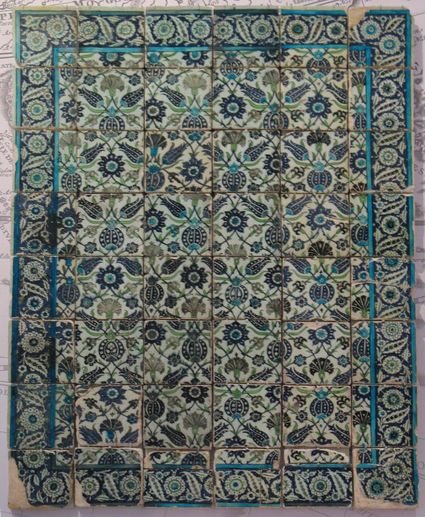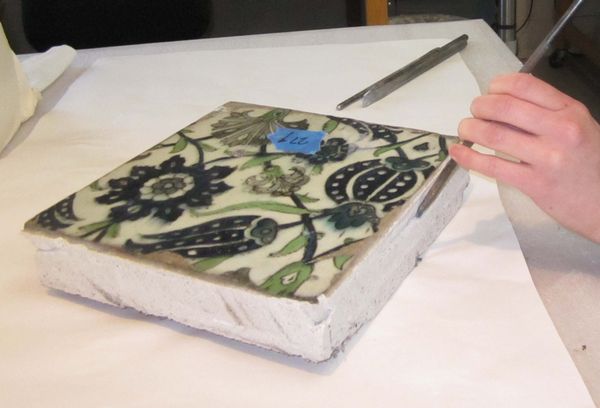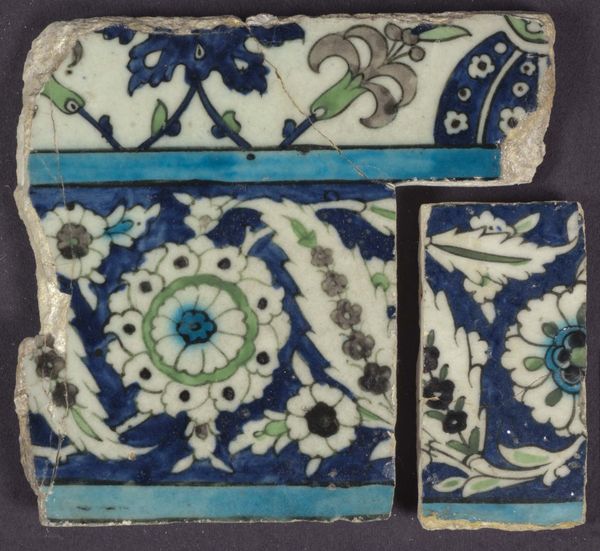Connecting with Conservation
If you’ve been through Connecting Cultures, you’ve probably wondered at the number of diverse objects. You may not be aware, however, of the planning and activity that goes into an installation of this depth. And if conservators have done our jobs, you hopefully won’t even know that we’ve been there—yet our work can have a dramatic effect on how artwork is presented.
An Islamic tile panel from Damascus, Syria (39.407.1-54) underwent extensive conservation for the installation. Previously the tiles had been assembled, set into concrete, and put into the wall of the Islamic Galleries. Losses and cracks were filled with plaster and painted a flat, medium brown. A common restoration for the early 20th century, this resulted in a panel that weighed over 800 pounds!

After Treatment, Panel of Tiles, 16th-17th c, Damascus, Syria, Gift of Alan Devereux, 37.409.1-.54
Since this structure was so cumbersome, the tiles were removed from the cement backing. We used a power saw to cut them apart along the grout lines, carefully avoiding the tiles, and then cleaved them from their backings.

Tiles were separated from the backing by inserting a chisel into air pockets between the tile and the cement after the tiles were cut out of the panel with a power saw (39.407.27)
After all of the old restorations were removed, we examined the tiles. Variations in technical characteristics between tiles indicated they could be from different sources. Many were broken and a few had smaller fragments of similar tiles inserted into losses. Several numbering systems were on the backs of the tiles and some were higher than the 48 tiles that existed in our construction, suggesting that the panel may originally have been larger.
These observations made us consider how the tiles should be displayed. Rearranging, cutting, and inserting fragments of mismatched tiles to make the pattern continuous had been widespread techniques for reconstructing tile panels, but was the current condition an accurate reflection of how the panel would have originally looked? Would leaving it fragmentary with missing tiles ruin the aesthetic?

In a previous restoration, fragments were inserted into trimmed tiles to create a complete tile. Here, the pattern is the same, but doesn’t quite match (39.407.46, .50)
We decided that all the tiles and fragments would be included in the new display. Tiles would be individually mounted without grout or restorations. The effect was that they would be separate objects, but each an integral part of a larger collection. This also allowed for changes that cement and mortar does not—tiles can be removed, displayed and examined separately without having to disturb the entire panel.

Art handlers perform a test hanging of the tiles before installing them in the galleries.
In creating this new mount, we were faced with another challenge: the panel would be installed over 6 feet above the floor. The mount would need to be easy and safe for installation, but satisfy concerns about the appearance. The tiles were mounted in columns on to backing boards, so that eight tiles could be installed at a time. When the boards were pushed together, they created the entire panel.
The newly conserved Islamic tile panel is in the “Connecting Places” section of Connecting Cultures. Tell us what you think! Were we successful in presenting a complete object? Do you miss the cement and grout of a traditional tile panel? Can you see the inserted fragments? Do the losses detract from the overall appearance?
Look for conservators and other Museum staff serving as “connectors” in the gallery to find out more about the objects in the installation.

Kerith Koss is the Andrew W. Mellon Fellow in Objects Conservation at the Brooklyn Museum. She received her Master's Degree in Art History and Conservation from the Conservation Center of the Institute of Fine Arts at New York University. Before joining the Brooklyn Museum in 2008, she was a Smithsonian Post-Graduate Fellow at the Freer Gallery of Art in Washington, DC. Over the course of her conservation training, she has completed internships at the Metropolitan Museum of Art, the Field Museum in Chicago and the Shelburne Museum in Vermont and has assisted in hurricane recovery efforts at several local museums on the Gulf Coast of Mississippi.
